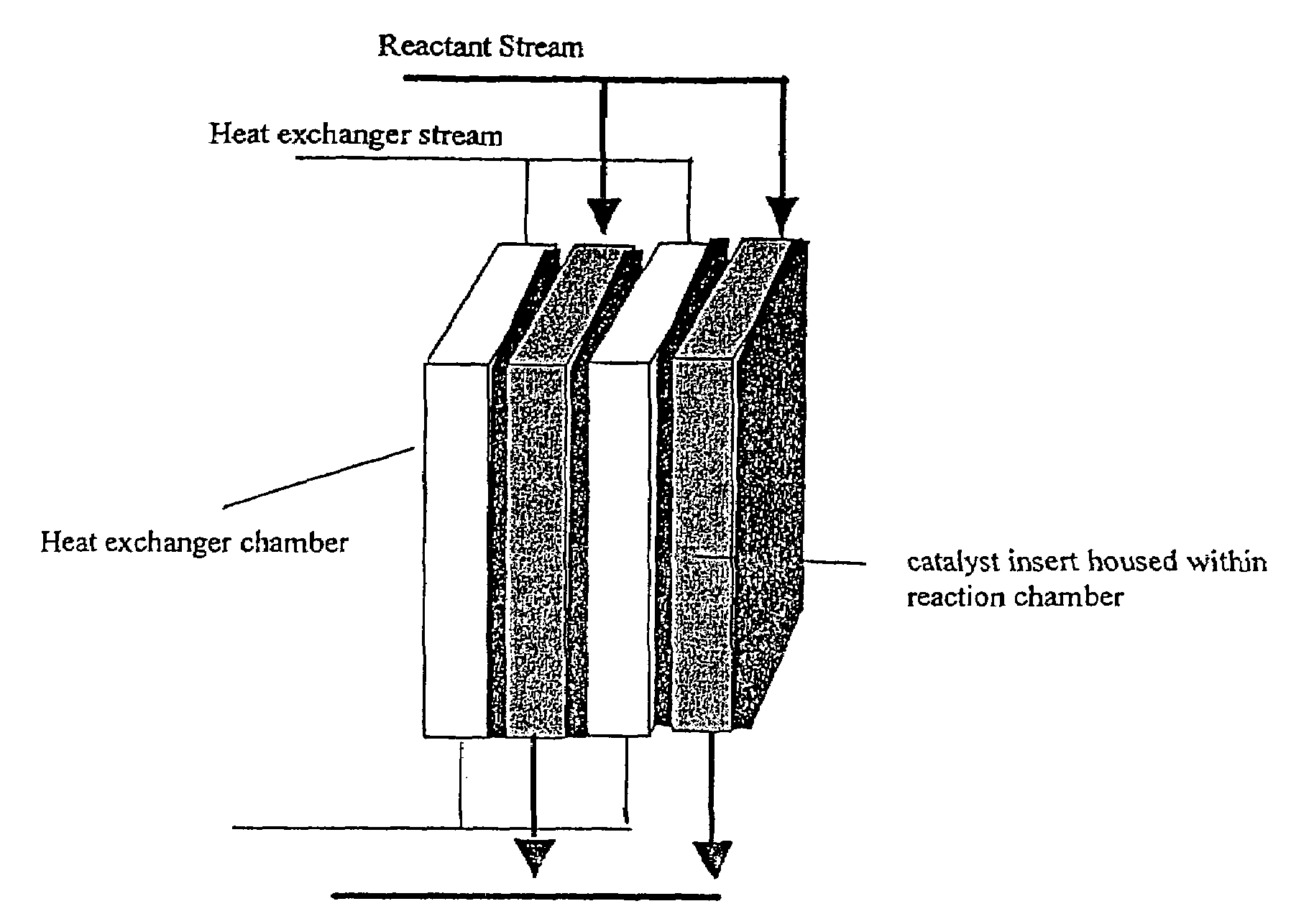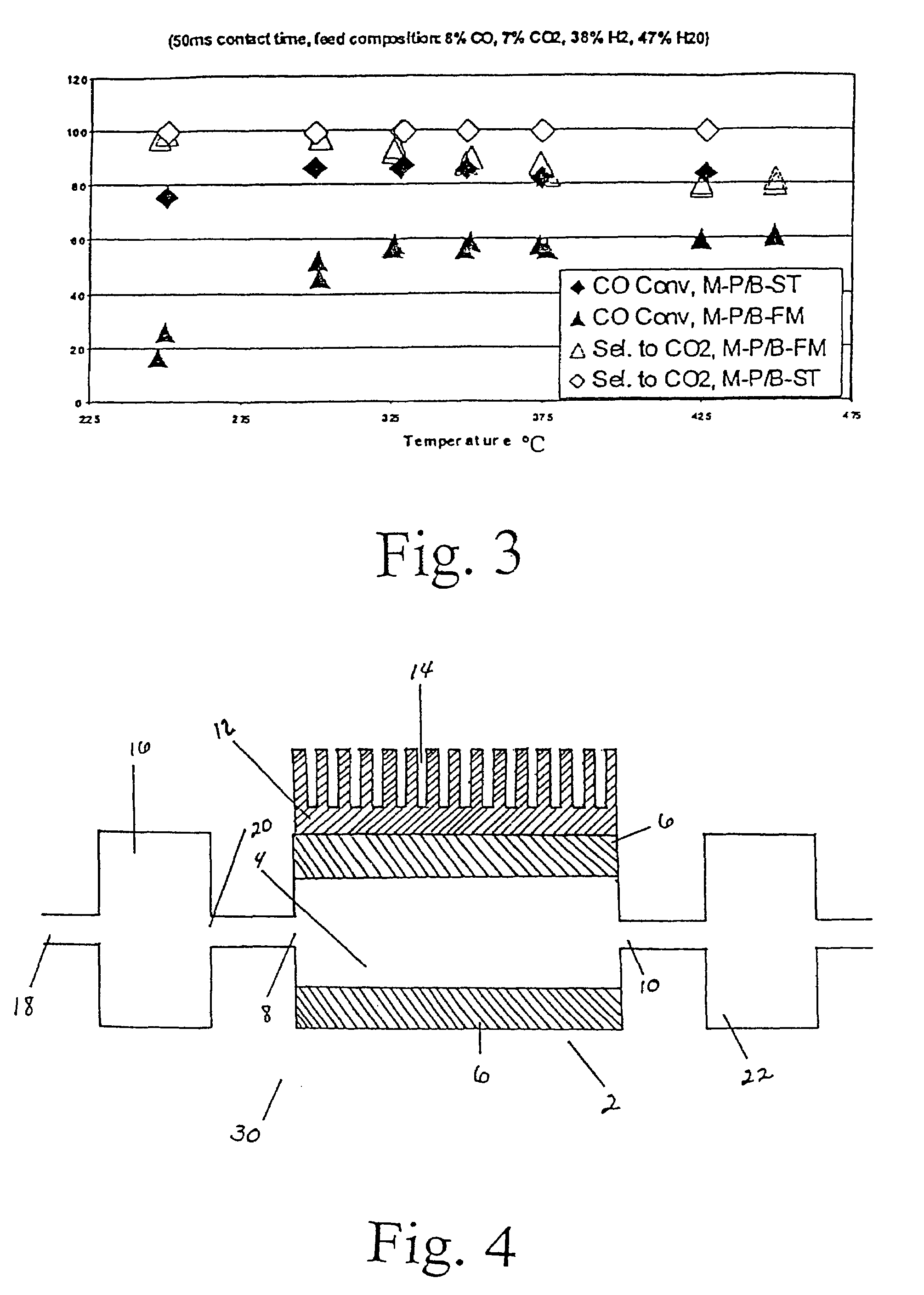Catalysts, reactors and methods of producing hydrogen via the water-gas shift reaction
a technology of catalysts and reaction reactions, applied in the direction of metal/metal-oxide/metal-hydroxide catalysts, combustible gas production, chemical production, etc., can solve the problems of catalyst deactivation, high reaction temperature, and both catalysts are not very active under their applicable conditions, and achieve the effect of superior results
- Summary
- Abstract
- Description
- Claims
- Application Information
AI Technical Summary
Benefits of technology
Problems solved by technology
Method used
Image
Examples
example 1
[0034]5 wt % Ru / ZrO2 catalyst was prepared by conventional incipient wetness impregnation. ZrO2 (6568-45-11F3 ⅛″ extrudates) was obtained from Engelhard, and ground and sieved into 70-100 mesh. Ru was impregnated onto the ZrO2 support to its incipient wetness point (0.4 cc / g) from an aqueous solution of RuCl3 hydrate (Aldrich, 99.98% ). The impregnated sample was set at room temperature for 30 min prior to drying under vacuum at 100° C. overnight. Finally, the catalyst was calcined under ambient conditions with a ramping rate of 5 C / min to 350° C. and isothermally held at that temperature for 1 h.
[0035]The water gas shift reaction was carried out in a conventional fixed-bed down flow reactor. The reactor used for powder testing has an inside diameter of 5 mm. Typical catalyst loading was 0.06 gram of 70-100 mesh particles. FIG. 1 shows an example of results from reaction of a gas mixture consisting of 8% CO, 7% CO2, 38% H2, and 47% H2O, over this powder 5 wt % Ru / ZrO2 catalyst, at a...
example 2
[0036]An improved powder catalyst, Ru / ZrO2 promoted with K, was also prepared using incipient wetness method. Specifically, a 0.5 wt % Ru-1.5% wtK / ZrO2 catalyst was prepared. ZrO2 (6568-45-11F3 ⅛′ extrudate) was obtained from Engelhard, and ground and sieved into 70-100 mesh. Ru and K were co-impregnated onto the ZrO2 support to its incipient wetness point (0.4 cc / g) from an aqueous solution of RuCl3 hydrate (Aldrich, 99.98% ) and KNO3 (Aldrich, 99.99% ). The impregnated sample was set at room temperature for 30 min prior to drying under vacuum at 100° C. overnight. Finally, the catalyst was calcined under ambient conditions with a ramping rate of 5C / min to 350° C. and isothermally held at that temperature for 1 h. Again, the water gas shift reaction was carried out in a conventional fixed-bed down flow reactor. The reactor used for powder testing has an inside diameter of 5 mm. Typical catalyst loading was 0.06 gram of 70-100 mesh particles. FIG. 2 shows an example of results from ...
example 3
[0037]The powdered catalyst described in Example 2 was also investigated in various engineered forms. Experiments were conducted to demonstrate the present invention using 1 microchannel for the water gas shift reaction. The microchannel was placed within a tube furnace to provide the required preheat for the exothermic reaction. The microchannel was 5-cm long and 0.94-cm high. The width (or opening) of the microchannel was 0.0762-cm or 762-microns. In the case of felt-supported catalyst, 0.0222 g of powdered 0.5% Ru-1.5% K / ZrO2 catalyst described in Example 2 was coated on a metal felt of FeCrAl alloy obtained from Technetics, Deland, Fla. The dimensions of the felt are 1.27 cm in length, 0.94 cm in width, and 0.0254 cm in thickness. The porous structure contained a catalyst of 0.5% Ru-1.5% K / ZrO2 powdered catalyst that was prepared by 1) ball-milling the powdered catalyst 0.5% Ru-1.5% K / ZrO2 (using same method as described in Example 2) overnight; 2) slurry dip-coated on the FeCrA...
PUM
| Property | Measurement | Unit |
|---|---|---|
| pore size | aaaaa | aaaaa |
| temperature | aaaaa | aaaaa |
| size | aaaaa | aaaaa |
Abstract
Description
Claims
Application Information
 Login to View More
Login to View More - R&D
- Intellectual Property
- Life Sciences
- Materials
- Tech Scout
- Unparalleled Data Quality
- Higher Quality Content
- 60% Fewer Hallucinations
Browse by: Latest US Patents, China's latest patents, Technical Efficacy Thesaurus, Application Domain, Technology Topic, Popular Technical Reports.
© 2025 PatSnap. All rights reserved.Legal|Privacy policy|Modern Slavery Act Transparency Statement|Sitemap|About US| Contact US: help@patsnap.com



